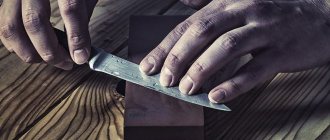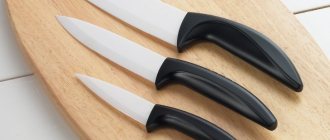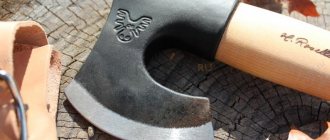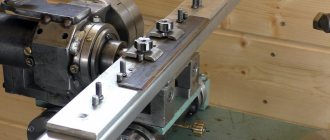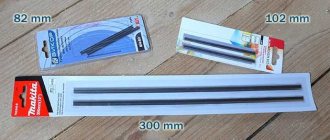If there are knives in the house, sooner or later they become dull and have to be sharpened. Despite the apparent simplicity of this procedure, sharpening knives, however, is quite a difficult task. Proper sharpening of knives is not available to everyone. This equally applies to sharpening kitchen knives, and sharpening collectible knives made of expensive steel, and knives for any type of professional activity. Let's consider the question of how to sharpen knives correctly.
What materials are stones for sharpening knives made of?
In this case we are talking about stones for manual sharpening of knives. Such stones (also known as whetstones for sharpening knives) come in four types, depending on the materials they are made from:
- made of ceramics;
- from diamond stones;
- from natural stones found in nature;
- from Japanese water stones.
Each of the listed bars has individual properties and characteristics.
Detailed characteristics of stones for manual sharpening of knives
Bars made from ceramic materials are considered the most common and affordable. For the most part, these are the bars that are sold in all hardware stores. Such bars are divided into several subtypes. The most common type of block is the “boat” type. This is a very low-quality whetstone: it can only be used for rough sharpening or straightening the sharpening angles of a knife blade. Somewhat better quality are bars that have a smooth surface on one side and a rough surface on the other.
As for diamond bars, professional sharpening of knives with their help is quite rare. Firstly, sharpening knives with diamond stones is difficult. Secondly, a blade sharpened with diamond stones very quickly becomes dull again. Thirdly, diamonds deeply scratch the cutting edge of a knife, and, in addition, destroy the blade itself, “eating” it.
It is best to sharpen knives using natural knife sharpening stones, as well as Japanese water stones. Most of them are brought from abroad, and they have a high price.
What is a "diamond block"
But what is a “diamond block”? As a rule, this is a lining made of plastic or aluminum, to which steel plates are attached on both sides. Abrasive diamond grains are applied to them using chemical treatment.
Interesting: some people believe that real diamonds are used on such bars, but this is not at all true, because in this case the stone would have a huge price tag. Today, to create such abrasives, artificial diamonds are used, which are much cheaper and even stronger than natural ones.
How to choose the right whetstone for sharpening a knife
When choosing a whetstone for sharpening a knife, there are several tricks. These tricks have been tested over the years and therefore should be taken into account. First of all, you need to pay attention to the size of the bar. Its length should be twice as long as the knife blade. If you intend to sharpen a knife with your own hands, you should also pay attention to what the surface of the block is. It should be smooth and free of cracks or scratches.
To sharpen kitchen knives, a double-sided ceramic whetstone is enough. You can also purchase two or three bars with different grain sizes for this purpose. It would be better if such bars were produced back in the USSR era. Soviet sharpening stones are considered the highest quality. Of course, you can’t find them in stores now, but you can still find them in markets and flea markets.
All these tips are quite acceptable for sharpening kitchen knives. If we are talking about sharpening more serious knives (for example, hunting ones), then in this case, in addition to sharpening stones, you also need the well-known GOI paste. After sharpening, it polishes the cutting edge of a sharpened knife.
What oil to use
Kitchen knives are processed in food grades. A few drops are enough to get a good result. The choice of oil depends on the metal from which the blade and abrasive are made, as well as on functionality.
Gun oil
It is sold in stores. Many people have weapons at home, and therefore this oil. The handle is treated with it. An excellent option for Ballistol. It has bactericidal, disinfectant and healing properties.
Gun oil.
Castor
Ideal for lubricating folding appliances. It needs to be changed frequently due to its thickness. Capable of attracting dust. Its vegetable composition has a positive effect on steel.
Castor oil.
Camellia oil
This is the highest quality and most expensive method. It is constantly used by craftsmen from Japan. Kurobara has been used in Japan for more than a century. Translated it means black rose.
Camellia oil.
The acid-free composition has a high degree of purification. It is neutral, odorless. Perfectly protects kitchen utensils from rusty deposits. It is also used for any cutting tools.
It is characterized by increased viscosity. This promotes the formation of a permanent, thin film. Protects the surface from interaction with oxygen. It is used in the following countries:
- Vietnam;
- Japan;
- China.
Compliance with the rules of sharpening knives
To properly sharpen a knife, you need to know and strictly follow the rules for sharpening it:
- It is necessary to strictly maintain the sharpening angle of the knives. A knife for a special application should have a sharpening angle of approximately twenty degrees. If this is a universal knife, then the sharpening angle can be greater (from 30 to 40 degrees). The sharpening angle largely depends on the quality of the steel of the knife blade. If the steel is of high quality, then sharpening can last a long time. Usually, kitchen knives are not sharpened at a small angle; for them, they try to maintain a larger angle;
- There is no need to press hard on the knife while sharpening. The strength when sharpening does not matter, but the sharpening stone very quickly fails;
- Before you start sharpening a knife, you need to wash the block with water diluted with some detergent;
- During the sharpening process, the blade should slide along the block, and not vice versa. Moreover, strictly from yourself, and not in the reverse order, and also not in the “back and forth” sequence. One side of the knife is sharpened until a so-called burr appears on the cutting edge. After it has appeared, the second side of the blade is sharpened in exactly the same sequence;
- After sharpening the knife on a coarse stone, it is recommended to complete the sharpening process on a fine-grained stone. The sharpening process in this case is the same.
If this is a kitchen knife, then after sharpening on a fine-grained stone, the process can be considered complete. If this is a more “serious” knife, then after using a fine-grained stone, the blade will have to be polished on the skin, using GOI paste.
Why use oil
When sharpening on special machines, it is worth using oil. In this case, you need to pay attention to which abrasive this or that oil is suitable for.
When manually sharpening on a stone (especially a water one) at home, it is enough to use water.
A few tips for working with oil:
- a thin layer guarantees access of the abrasive grain to the metal;
- thinner stones require a thinner layer of liquid;
- the formation of a hard layer is unacceptable due to the possibility of blocking stone and grain;
- each stone has its own oil;
- the formed metal shavings must be contained in the liquid;
- The use of engine fluid is prohibited.
When sharpening
Protects against clogging with metal particles. The block is lubricated. It is unacceptable to use organic or sunflower varieties. They salt the bar.
When cleaning
Use light special oil. The bar is moistened. Then clean with a brush.
Olive oil.
Read more about sharpening Japanese knives
Sharpening Japanese knives is done according to a slightly different principle. The fact is that the blade of Japanese knives has a slightly different design than most other knives. Japanese knives are sharpened only on one side. Thanks to this geometry, products cut with a Japanese knife cannot stick to the knife blade.
Otherwise, Japanese knives are sharpened like all others. First, there is preliminary sharpening on a stone with a rough surface, after which sharpening is completed using a fine-grained sharpening stone. Finally, the sharpened edge is ground.
Corrosion removal
The blade must be cleaned of rust. There are 3 types of corrosion:
- pitting – the easiest damage. A regular eraser or an old toothbrush with most of the bristles cut off can handle it. It is dipped into a car polish containing small abrasive particles;
- Cavities – medium degree. First, treat with scratch polish, and then use a fine abrasive polish;
- Serious corrosion is fought with an abrasive sponge and fine-grained sandpaper. After this it needs to be polished. Polishing reduces the surface. Without this process, rust will appear in even greater quantities.
What is a knife sharpening machine?
Many people by a machine for sharpening knives mean all sorts of homemade sharpening units. In fact, sharpening knives with such sharpeners is extremely undesirable. With just a few sharpenings, a homemade knife sharpening device can ruin any knife to such an extent that all that remains is to throw it away.
It is better to purchase a factory-made knife sharpening device. With its help, knives are sharpened quickly and reliably, to a razor-like state. In addition, with the help of such a device you can easily make the desired sharpening angle. True, a factory-made device for sharpening knives costs a lot, more than 7 thousand rubles.
We attach the material in the form of pictures
1. We begin the passage from the back (closer to the handle) part of the blade.
2. When we reach the place where the blade bends in an arc - its “belly”, we begin to smoothly lift the handle of the knife in order to maintain a constant sharpening angle along the entire length of the blade.
3. At the end of the pass, the tip should remain on the block.
4. When we have mastered one side of the blade, turn the blade over to the opposite side and repeat everything from the beginning (5 and 6).
5. You can sharpen a knife on a block “from yourself/towards you”, you can “from left to right/right to left”.
6. After profiling the cutting wedge, it is necessary to polish it on a finer whetstone.
Let's move on to the main thing...
Device for sharpening knives at home
However, a high-quality device with which to sharpen knives at home can be made with your own hands. It's not that difficult. A drawing for such a device can easily be found on the Internet.
You can find instructions on the Internet for making two homemade knife sharpening devices. One device in its design resembles a branded Lanski sharpener. Another attachment is very similar to the Edge Pro Apex model. The first sharpener is easier to make than the second, but on the second model you can sharpen a knife faster and with better quality.
Knife sharpening kit in the field
If someone needs to go hunting, or hiking, or geological exploration, or for some other need, then, of course, a complete set for sharpening knives may not fit in a backpack. However, it is highly recommended to put a cut-down knife sharpening kit in your backpack. A double-sided block, a piece of leather for straightening the blade - this is a camp set for sharpening knives.
Such a set can be very useful in field conditions. It is clear that you cannot sharpen a damask blade with such a set, but for a simpler blade, a camp knife sharpening set will do just fine.
Advantages and disadvantages
Experts say that the Venevsky whetstone will remain flat even after sharpening several hundred knives. The product is in wide demand due to other advantages:
- the presence of very sharp edges (compared to other abrasives), ensuring the most efficient straightening of the blade;
- durable metal base, which eliminates the possibility of damage to the abrasive tool due to impacts or falls during operation - due to this characteristic, the service life of the product will be long;
- there is no need to use special oil during sharpening, the treated surface is wetted with ordinary water;
- cleanliness of the tool when working with metal products - the probability of clogging the bar with particles of the processed steel is zero;
- preservation of the working surface of the product over a long period of time due to the rapid grinding of steel;
- no need for special care - after use, the bar only needs to be rinsed under the tap and wiped dry with fiber or a rag.
Despite the large number of advantages, Venev bars have certain disadvantages. Sharpening of knives should be carried out by a master with the appropriate skills; inept handling of the product can lead to complete damage to the blade. The cost of the tool is quite high, which makes it inaccessible to a wide range of buyers. But the price is justified by the duration of operation.
What mistakes can be made when sharpening knives?
When sharpening knives, you can make a number of typical mistakes:
- It is impossible to fully sharpen a knife with just one stone. For proper sharpening, you need to use several stones with different degrees of grit;
- The knife may not be sharpened without noticing small burrs on the cutting edge;
- It is impossible to fully sharpen a knife without first cleaning it from any remaining dirt or grease;
- Another mistake is choosing the wrong sharpening angle. With a large sharpening angle, it is very difficult to cut food in thin layers with such a knife. With a large sharpening angle, the knife will soon become dull in the process of slicing hard products.
A knife can be fully sharpened only if all of the simple rules listed above are observed.
